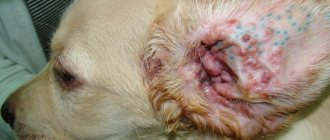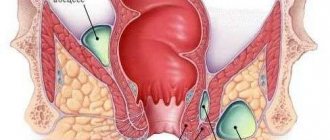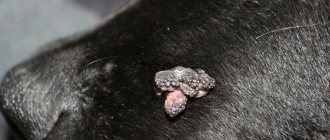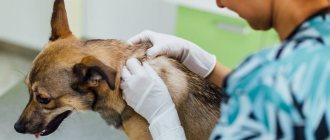Why does bronchitis occur in dogs?
Has your dog swam in icy water, accompanied you in the rain, or found yourself outside in freezing weather? Or maybe you kicked him out the door and he stood in a draft? In any of these cases, the animal experienced hypothermia, which weakened the immune system and provoked the appearance of a focus of inflammation in the bronchi. Disruption of the normal functioning of the bronchi can be caused by prolonged exposure to smoke, dust, or inhalation of hot or cold air. The risk of the disease increases as a result of inhalation of gases and the entry of various types of fungus into the bronchi.
Causes of bronchial inflammation
Classification according to the type of discharge is of great diagnostic importance:
- catarrhal bronchitis;
- purulent;
- fibrinous;
- hemorrhagic;
- putrefactive.
The etiology of primary forms of bronchial inflammation often involves deterioration of living conditions. Cold factors (low temperature, draft, high humidity) are a common cause of bronchitis in dogs. Inhalation of hot air, dust, and smoke is also dangerous for the animal - this leads to irritation of the mucous membrane. A deficiency in the diet of vitamins A, B, C and proteins predisposes to the disease.
The chronic course is usually associated with less intense exposure to pathological factors or improper (incomplete) treatment of the acute form. Secondary bronchitis in a dog is a consequence of pathologies of other parts of the respiratory system - laryngitis, tracheitis, pneumonia. And also with coughing and discharge, one should assume infectious diseases - plague, adenoviral infection, tuberculosis.
The mechanism of development of bronchitis in a dog:
- influence of etiological factor;
- irritation of the mucous membrane, development of an inflammatory reaction;
- a painful reaction and accumulation of exudate provokes a coughing attack;
- the respiratory surface decreases, shortness of breath appears;
- the development of pathogenic microflora leads to increased pathological effects.
The chronic course develops smoothly. Instead of a pronounced inflammatory reaction, connective tissue grows in the bronchi, replacing the mucous epithelium. The contractile function of the bronchi decreases, the respiratory surface is lost - the respiratory tract and alveoli expand. Emphysema may occur.
Repeated inflammatory pathologies of the respiratory tract and irritation of the mucous membrane play an important role in the development of chronic bronchitis. This leads to changes in tissues, mucus production increases. The surface of the respiratory tract decreases, the working volume of the lungs decreases. Old and middle-aged animals are susceptible to the disease. There is a predisposition in small breeds, especially terriers and cocker spaniels.
Acute infectious bronchitis is observed in puppies in crowded conditions - nurseries, pet stores. The trigger mechanism is usually damage to the mucous membrane, which is then complicated by various flora. When examining bronchial secretions in dogs, streptococci, staphylococci, pasteurella, salmonella, bordetella, and mycoplasma are detected.
Primary factors
It is possible to recognize the onset of the disease by external manifestations. In the primary type, the occurrence is provoked by the same reasons as in humans:
- Hypothermia. Representatives of smooth-haired breeds should be wary of autumn and winter walks without warm clothing. But this is not the only potentially dangerous situation. The first summer swims in open water, as well as cases when, after a heat in a car or on the street, the dog finds itself in a cool room or under gusts of cool wind. The dog gets cold easily even due to drafts in the house.
- Extended periods of exposure to rain or regular walks during high humidity.
- Lying for a long time on cold surfaces: ground, concrete, asphalt.
- Regular inhalation of dust, smoke, various gases, cigarette smoke, vapor from vapes, and cosmetic spray compounds.
- Lack of vitamins A and C in food.
Secondary factors
There are many diseases that contribute to the appearance of bronchitis as a secondary complication. Some of them are contagious and not, deadly and practically unnoticed, but in any case, without quality treatment they will lead to the rapid development of an acute form of bronchial inflammation:
- Infectious diseases plague and adenovirus.
- Laryngitis.
- Pleurisy.
- Pneumonia.
- Hypervitaminosis A.
- Tracheitis.
What contributes to the disease
Who is at risk? These are, first of all, young dogs, and those that can be called “older”. If your pet has not yet recovered from stress, a long-term illness, surgery, or is not eating well, then cold and infections pose a particular danger to him.
Another common cause of the disease is excess weight. Bronchitis often occurs in animals that have unhealthy teeth; the infection spreads from the oral cavity to the bronchi very quickly.
What is bronchitis, its types in animals
Bronchitis is the development of an inflammatory process in the mucous layer of the bronchi in a dog. The pathology is characterized by sudden bouts of coughing and nasal discharge.
The inner layer of the bronchi secretes mucus throughout life. One of its main functions is protective. Mucus helps get rid of foreign objects and also contains a lot of proteins. This composition creates a bactericidal barrier and does not allow pathogens to penetrate into the respiratory tract. With the development of bronchitis, the mucous layer becomes inflamed, the protective function is disrupted and the bronchi become susceptible to the penetration of pathogenic microorganisms. The process is accompanied by the accumulation of exudate, as a result of which the lumen of the bronchi narrows and gas exchange is greatly reduced.
By origin, the pathology is:
- Primary, when inflammation develops as an independent disease.
- Secondary, when bronchitis is a symptom or complication of the underlying disease.
According to the nature of the course, inflammation is divided into:
- Acute - lasts less than 10 days, symptoms are obvious. If a dog with this form receives inadequate treatment, bronchitis becomes chronic.
- Chronic - pathology lasts more than 10 days. The pet initially shows improvement, but then the symptoms worsen again and recur periodically.
In veterinary medicine, bronchitis is also distinguished by the type of inflammation:
- serous;
- catarrhal;
- purulent;
- putrefactive;
- fibrinous;
- hemorrhagic.
Classification of bronchitis
Based on its origin, bronchitis is divided into two types:
- primary. Arises as an independent disease of the upper respiratory organs;
- secondary. Occurs as a result of an exacerbation of a viral disease.
If we take the localization of inflammation as a basis, then bronchitis has three types:
- microbronchitis Involves inflammation of the small bronchi;
- macrobronchitis. Covers large bronchi;
- diffuse pneumonia. Distributes to the entire bronchial tree.
During bronchitis, the pet coughs heavily, vomits and discharges from the nose
Table 3. Types of bronchitis according to the nature of the inflammatory process
Types of bronchitis Description
| Purulent | Severe inflammation of the bronchi, accompanied by a severe cough and discharge mixed with pus |
| Fibrous | An inflammatory process accompanied by a severe cough with bloody discharge |
| Catarrhal | An inflammatory process that is accompanied by copious sputum production |
| Putrid | Chronic bronchitis accompanied by a putrefactive infection. If treatment is ineffective, it leads to gangrene of the lungs and ichorous pleurisy. |
| Hemorrhagic | A very dangerous type of bronchitis, in which the discharge of blood is very profuse, which can lead to the destruction of bronchial tissue |
Table 4. Classification of bronchitis by form
Types of bronchitis Description
| Spicy | A sudden onset of an inflammatory process that develops against the background of a viral infection and lasts at least 14 days. If not treated correctly, it becomes chronic and incurable. |
| Chronic | Occurs as a result of an untreated respiratory disease or a constant irritant |
| Allergic | Accompanied by attacks of suffocation, painful cough and copious sputum production |
View of healthy bronchi (left view) and inflamed (right view)
Primary and secondary bronchitis
Primary bronchitis is the result of a cold; its appearance can be triggered by the factors mentioned above. But secondary is a consequence of another illness. It appears as a result of inflammation in the larynx or lungs; tracheobronchitis in dogs is not uncommon, when the inflammatory process affects both the bronchi and trachea.
A painful cough may indicate the presence of parasites in the body, or be caused by allergies. Bronchitis accompanies adenovirosis, laryngitis, tracheitis, and pneumonia. Tumors and enlarged nodes also often cause this disease. Without special knowledge and equipment, it is difficult to examine an animal and establish the true cause of the disease. Frequent and prolonged cough should alert you and be a reason for a visit to the veterinarian. Only after a detailed examination of the animal will a specialist be able to determine the cause and prescribe effective treatment.
Attention! A negligent attitude towards your pet’s health can cause the disease to progress and soon become chronic.
If time is lost, gas exchange and other processes occurring in the bronchi are disrupted, and the lack of oxygen will cause a number of pathologies. And, soon, your friend will acquire a whole bunch of diseases, including the nervous and cardiovascular systems.
How does secondary bronchitis differ from primary bronchitis?
If primary bronchitis occurs due to a cold or inhalation of irritating substances, then secondary bronchitis always comes after another disease. The inflammatory process that begins in the larynx, trachea, and lungs can spread to the bronchi. In addition, the cause of a painful cough may be damage to the respiratory organs by parasites or an allergic reaction.
Bronchitis can occur due to the presence of other diseases in the dog.
Bronchitis in dogs develops as a result of the following diseases:
- plague;
- rhinotracheitis;
- adenovirus;
- laryngitis;
- tracheitis;
- pleurisy;
- pneumonia;
- helminthiasis;
- allergy.
The causative agents of bronchitis can be viruses, bacteria, and parasite larvae . Sometimes bronchitis develops due to compression of the respiratory organs by a tumor or enlarged lymph nodes (with tuberculosis, leukemia).
At home, it is difficult to determine the type of bronchitis and its causes. If your pet is coughing, he needs a full examination of the body. Only a veterinarian can choose a treatment method that will eliminate the underlying cause of the disease.
Attention! If bronchitis is not treated or treated incorrectly, the disease becomes chronic. Against the background of prolonged inflammation, gas exchange in the bronchi is disrupted. The dog’s body suffers from a lack of oxygen, and this is a sure path to cardiovascular and nervous diseases.
Treatment methods
If the dog's condition is stable, bronchitis can be treated at home. The therapy used is aimed at destroying the pathogen, eliminating negative factors and suppressing anxiety symptoms.
Taking medications
Most drugs are sold in a regular pharmacy and are intended for humans. You should not follow the instructions on the package, since the body of your four-legged friend is very different from ours. Thanks to a more developed metabolism, the active substances are eliminated faster, so the standard dosage often has to be increased.
Basic drugs for inflammation in the bronchi include:
- enzymes
(Trypsin, Chymotrypsin)
to thin sputum; - anthelmintics
(Pyrantel, Levamisole)
that destroy pulmonary parasites; - bronchodilators
(Acetylcysteine, Ephedrine, Albuterol)
, helping with bronchospasm; - nasal drops
(Tsiprovet, Anandin, Pinosol)
, recommended for rhinitis; - antihistamines
(Zyrtec, Diphenhydramine, Suprastin)
and glucocorticosteroids (Prednisolone, Dexafort), suppressing allergic reactions; - mucolytics
(Lazolvan, Ambroxol, Mucaltin)
, thinning thickened sputum; - cardiac glycosides
(Adonizide, Digoxin)
, which increase the performance of the heart; - antibiotics
(Amoxicillin, Enroxil, Streptomycin)
that fight bacteria.
The listed medications should be taken strictly as prescribed by your veterinarian. The disappearance of symptoms a few days after starting treatment is deceptive. If drug therapy is discontinued before complete recovery, the signs of the disease return.
Physiotherapy
Complex therapy is not complete without physiotherapy. It is recommended to warm up a sick pet with an infrared lamp. It facilitates mucus discharge and strengthens the immune system. Additionally, the veterinary clinic offers a course of UHF therapy and diathermy.
In addition to warming up, steam inhalations should be performed. The easiest option is for the dog to stay in a heated bathroom. If there is a special nebulizer spray device in the house, then it is better to use it.
If you have a chronic pathology caused by bronchial asthma, you should try inhalation using a spacer for animals. Thanks to them, you can suppress emerging attacks and prevent the occurrence of new ones.
Taking vitamins and immunoboosting drugs
For a speedy recovery of your four-legged pet, you will have to stimulate its defenses. For this purpose, vitamin A, ascorbic acid and immunomodulators (Anandin, Fosprenil, Gamavit) are prescribed. These drugs restore epithelial cells and increase the production of antibodies designed to neutralize pathogenic microorganisms.
Types of bronchitis
Among bronchitis occurring in dogs, there are three main types:
- spicy;
- chronic;
- allergic.
Each of these types requires its own treatment regimen, which is clarified by the veterinarian after diagnosing the animal.
Acute bronchitis
During acute bronchitis, the dog completely loses its appetite, lethargy appears, a slight body temperature and a rapid pulse occur. The cough is dry, eventually turning into a wet one, with strong debilitating gusts and vomiting. Severe wheezing and whistling sounds are noted. If the disease is not diagnosed in time and treatment is not started, inflammation can affect the entire respiratory system.
A severe cough can turn into bouts of vomiting in an animal.
Chronical bronchitis
The disease progresses slowly. Chronic bronchitis can be distinguished by a cough that lasts more than 8 weeks. Inflammation can be latent, disappearing and reappearing. This bronchitis cannot be completely cured and is accompanied by the following manifestations:
- cough for more than 8 weeks;
- dyspnea;
- blue gums;
- wheezing, whistling when breathing;
- apathy, weakness.
Symptoms of bronchitis
The main symptoms of bronchitis:
- elevated temperature;
- loss of appetite;
- weakness, apathy;
- chills;
- cough.
With constant exposure to a negative factor, swelling and excessive blood overflow of the vessels of the bronchial mucosa occur. Also, a large amount of secreted fluid is formed on the mucous membranes. The type of disease can be determined by the quality of the discharge. Accumulation of sputum occurs in the lumen of the bronchi. A layer of epithelial tissue cells, white blood cells, and erythrocytes (red blood cells) accumulates in the fluid. Without proper treatment, inflammation spreads and leads to disruption of gas exchange in the body. Extensive intoxication occurs as inflammatory products are absorbed into the blood.
One of the signs that a dog is sick is apathy and loss of appetite.
A dog with bronchitis is apathetic and inactive. In addition, breathing becomes heavy and difficult. A dry cough develops, which turns into a painful cough with sputum production. Exudate is released when coughing and through the sinuses, having a mucopurulent appearance.
Symptoms of the disease
With bronchitis in dogs, coughing, loss of appetite, fatigue, and rapid pulse are observed.
With acute bronchitis in animals, the following ailments are observed:
- cough;
- noisy breathing;
- poor appetite;
- fast fatiguability;
- increased body temperature;
- rapid pulse.
Cough is the main symptom of bronchitis. At the beginning of the disease, the cough is dry, after 3-5 days it becomes wet. Intense cough may be accompanied by gagging or vomiting. The dog is breathing noisily; dry or moist wheezing may be heard in its breathing. An increase in temperature with this disease does not always occur.
With bronchitis, animals often suffer from a runny nose. With a strong inflammatory process, when the dog does not have enough air due to coughing, nasal congestion and shortness of breath, a state of hypoxia may occur. In this case, the pet’s tongue and gums become pale or bluish.
Signs of chronic bronchitis
Chronic bronchitis is a long-term inflammatory process in the bronchi. If a dog's cough does not go away within two months, it means it has become chronic. In dogs, bronchitis progresses slowly and cannot be completely cured.
The main signs of chronic bronchitis:
- prolonged cough (more than two months in a row);
- dyspnea;
- blue or pale mucous membranes;
- fainting;
- breathing with whistling, wheezing;
- fast fatiguability.
With chronic bronchitis in dogs, shortness of breath, fainting, fatigue, and more are observed.
The animal constantly coughs, with periods of remission followed by periods of deterioration. A cough with chronic inflammation of the bronchi is usually dry; during periods of exacerbation, sputum appears. Over time, your pet may develop COPD (chronic obstructive pulmonary disease).
Risk group
First of all, weakened animals are at risk:
- old dogs;
- puppies with undeveloped immunity;
- sick or recovered pets whose immune system is weakened.
Some breeds are prone to certain types of this disease:
To eosinophilic: Rottweilers and Arctic breeds, mongrels, Jack Russell terrier, cocker spaniel, German shepherd, Labrador retriever, dachshunds.
Primary is more common: in hunting dogs, brachycephalics (due to structural features), large breed dogs.
Clinical symptoms
Chronic bronchitis is defined by a daily cough for no apparent reason for at least 2 months of the year. The cough is primarily dry and harsh, but can be wet and productive, producing large amounts of secretions, and in dogs with tracheal collapse, this symptom may be obscured by a cough called a "cackle." Often a dog has been coughing for several years before being brought to the veterinarian due to an acute worsening of symptoms. Exacerbation of chronic bronchitis is associated with the progression of inflammatory lung disease or pulmonary infection.
Chronic bronchitis is considered a classic disease of dogs and is often diagnosed in poodles, terriers and dachshunds. However, for this reason, large dogs should not be ignored. Typically, chronic bronchitis is observed in middle-aged and old dogs, but the onset of the disease can also occur very early - at 3-4 years.
On general examination, the dog appears healthy, but is often overweight. Most often, rough, diffuse and crepitating rales are noted, which are harsher and louder than with pulmonary edema or pneumonia. At rest, lung sounds may be normal, but upon auscultation, post-cough crackles and wheezing are heard. Tracheal tenderness is usually present due to nonspecific airway inflammation. Associated tracheal collapse is identified by a cough that sounds like a "cackle" or by crepitating sounds heard inside the chest when the airways compress during exhalation. Dogs with severe bronchitis will have a prolonged exhalation with an expiratory thrust and a history of cyanosis or collapse is common in these animals.
How to determine bronchitis in a dog?
Only a veterinarian can make an accurate diagnosis and establish the cause of inflammation. To do this, the doctor conducts a general examination and a number of studies:
- First of all, the veterinarian collects information about the dog: how long has it been sick, whether vaccinations have been carried out, what other symptoms there are, what kind of food the pet receives.
- Breathing assessment: frequency, depth, rhythm, presence of shortness of breath.
- Establishing the type of breathing: thoracic, abdominal, thoraco-abdominal.
- Presence of cough (without this symptom a latent chronic form of bronchitis is possible).
- Auscultation (will reveal wheezing, cardiac dysfunction).
- Thermometry.
- Blood tests (general clinical and biochemical).
- X-ray (the image evaluates the bronchial pattern, position of the lungs, and the presence of tumors).
- If necessary, bronchoalveolar lavage and bronchoscopy are performed to take swabs.
- Diagnosis of viral diseases: PCR, ELISA, serological studies.
Causes of bronchitis
Veterinarians note the following causes of bronchitis:
- hypothermia of the body. Long stays in rainy, frosty weather, walking in cold gusty winds, prolonged swimming in cold water;
- ill-conceived content. Being in a cold house, lack of warm bedding;
- lack of balanced nutrition. For a healthy body and a strong immune system, the supply of essential vitamins and minerals is very important. The presence of retinol and ascorbic acid supports the immune system, which protects the body from viral and fungal infections;
Proper nutrition is the basis for a strong immune system
- poisoning by toxic fumes. Tobacco smoke, aerosols, and household chemicals are very dangerous for your pet. The first to suffer is the respiratory system, which is constantly exposed, irritating the mucous membranes of the bronchi, as a result of which the inflammatory process is activated;
- allergic reactions. Reaction to food ingredients, medications, household chemicals, dust, pollen from indoor plants, developing swelling and inflammation of the bronchial mucosa;
- infection. Damage to the body by a viral infection, helminths, bacteria, fungi leads to inflammation and aggravation of the disease.
Hypothermia while in cold water leads to the development of lower respiratory diseases
Treatment
To cope with any disease, you first need to make a correct diagnosis. So with inflammation of the bronchi in dogs, it is necessary to establish not only the disease itself, but also the cause that caused it and at what stage the pathological process is currently located. Therapeutic measures completely depend on this.
A correct diagnosis can only be made in a clinical setting. Do not neglect your pet’s health and contact a veterinarian in a timely manner!
First aid:
- Arrange a warm place in the room without drafts.
- Provide adequate feeding and warm drinks.
- Contact a veterinary clinic for a full diagnosis.
Additional treatment
Obesity worsens the clinical symptoms of chronic bronchitis by reducing the compliance of the chest walls, increasing respiratory activity and increasing abdominal pressure on the diaphragm. Even with one weight loss, a decrease in the patient’s fatigue and an increase in oxygen levels in the arterial blood are already observed. The owner must clearly set himself the task of losing the dog’s weight over a certain period of time. It is advisable to lose weight by 2-3% per week. To do this, use a diet rich in fiber and low in fat, as well as gradually increasing physical activity.
For dogs with a collapsed trachea or a sensitive trachea, it is better to use a harness instead of a collar. The animal should be kept in a cool and clean area, avoid smoking, exposure to pollutants, and avoid being in hot or humid conditions.
To clear the respiratory tract of secretions in some animals, it is desirable to humidify the air currents by inhalation or spraying. For airway therapy, it is better to use an ultrasonic nebulizer, which produces very fine droplets of water that penetrate deeply into the airways. To humidify and saturate the air with oxygen, the nebulizer is attached to an oxygen cushion, or a hand-held nebulizer is attached to the oxygen tube of the anesthesia machine, and air is supplied through a mask. Massage tapping movements on the chest and moderate physical activity after spraying help cleanse the respiratory tract.
Prevention measures
- Conduct annual routine vaccination against viral infections.
- Give anti-helminth medications once every 3-4 months.
- In the warm season, carry out treatment against ectoparasites in a timely manner.
- Balanced diet. Selecting good quality commercial feed or selecting ingredients to create a complete homemade diet.
- Provide optimal conditions for keeping the pet (monitor the level of humidity in the room, temperature conditions).
- Avoid contact of the dog with irritating and harmful gases and chemicals.
- In the cold season, representatives of smooth-haired breeds wear special insulated suits for walks.
- When kept in a shelter or nursery, sick and newly arrived animals are isolated for the entire period of treatment or for the duration of quarantine. The premises are periodically disinfected with special solutions.
- When kept in enclosures in winter, food and drinking water are heated.
Bronchitis in dogs can develop as an independent disease or be a concomitant symptom of serious pathologies. In any case, the pet’s quality of life decreases due to disruption of gas exchange processes in organs and tissues. After a series of necessary studies, the veterinarian prescribes treatment, which must be carried out in full to prevent the pathology from becoming chronic.
Care and special diet
Treating bronchitis in dogs at home involves creating a comfortable and safe atmosphere. The bed of a sick pet is placed away from drafts and noise. The most remote room in the house, which excludes a lot of traffic, is suitable. Communication with other animals and hyperactive children should be limited. You should also exclude the presence of a TV, radio or other sources of loud sound.
It is better to avoid walking in frosty and rainy weather. It is much safer to use a tray. If the dog is quite large, then before going outside, warm his chest with a scarf or thick vest.
Eliminate contact with allergens or at least minimize their amount. Thanks to daily wet cleaning, you can get rid of dust and pollen flying into the window.
Before recovery, you should review your usual menu in favor of easily digestible and satisfying dishes. Don't overheat them above room temperature, but don't serve them cold either. For more effective phlegm removal, diversify your regular water with chamomile or linden infusion.
Danger of bronchitis
Without proper treatment, bronchitis easily becomes chronic. This species is very difficult to treat and remains with the pet forever, either disappearing or appearing again. The slightest factor instantly provokes the disease, weakening the pet each time. The most advanced degree of the disease on examination is manifested:
- emphysema;
- bronchopneumonia;
- severe shortness of breath;
- exhaustion.
These companions of a severe form of the disease entail an unfavorable prognosis, and, as they progress, most often lead to death, provoking heart and pulmonary failure.
Sources
- https://RealPet.ru/zdorovie/bronxit-u-sobaki.html
- https://yarus-spb.ru/sobaki/bolezni/lechenie-bronhita-sobak.html
- https://clubsobak.ru/2019/04/06/bronhit-u-sobak/
- https://pets-expert.ru/bronxit-u-sobak-simptomy-i-lechenie/
- https://sobaki-pesiki.ru/bronxit-u-sobaki-simptomi-i-lechenie.html
- https://PetGuru.ru/zdorovie/bronhit-u-sobak
- https://dogworry.ru/veterinariya/bronhit-u-sobak-simptomy-lechenie.html
- https://zootvet.ru/bronhit-u-sobak/
[collapse]
Which dogs are more likely to get bronchitis?
After bathing, dogs with long hair are at risk of getting bronchitis, since the hair is not yet dry and the ambient temperature is low. But dogs of smooth-haired and toy breeds are more at risk, as they have poor heat exchange. Having a special anatomical structure of the nasal passage, brachycephalic breeds are predisposed to respiratory diseases - this is what most veterinary specialists believe.
A dog of any age can get bronchitis, but weakened animals are more often susceptible to this disease.
Weakened animals and dogs over six years of age are also at risk and can easily catch a viral infection, which will trigger the development of bronchitis. Stress, weak immunity, and oral diseases are also factors in the spread of infection, which leads to bronchitis.
How is the diagnosis carried out?
The diagnosis is made by a veterinarian based on data received from the animal owner about the symptoms of the disease and laboratory tests.
Important! A dog's normal body temperature is within 38.3
–
39.4
°
C.
Diagnostic tests that may be prescribed for suspected bronchitis include:
- general blood analysis;
- microbiological and virological studies;
- blood gas analysis;
- X-rays of light;
- electrocardiogram.
The doctor must exclude the possibility of infectious diseases with similar symptoms: canine distemper, parainfluenza, adenovirosis. If helminthiasis is suspected, the veterinarian will order a blood test, since some parasites can affect the heart and lungs. If there are worms in the organs, the doctor performs an ultrasound scan.
Varieties
The causes of bronchitis are:
- primary;
- secondary (if bronchitis was the result of another disease).
By type of bronchial involvement:
- microbronchitis;
- macrobronchitis;
- diffuse pneumonia.
By type of discharge:
- purulent;
- fibrinous;
- catarrhal;
- putrefactive;
- hemorrhagic.
Depending on the speed of progression, bronchitis can be acute or chronic. Acute bronchitis occurs suddenly and lasts 2-3 weeks, most often resulting from viral infection. If it is not cured, it becomes chronic, which is practically incurable.
Symptoms
If you do not take into account some features of the course of individual types of bronchitis, the main symptoms are the following:
- Long, continuous painful cough.
- Redness and swelling of the mucous membrane of the conjunctiva of the eye, pharynx and bronchi. The latter can only be seen during bronchoscopy.
- Large secretion of mucus (phlegm).
- Wheezing that can be heard even from a distance.
- Loss of appetite.
- Reduced activity, refusal to walk or any activity.
Even the appearance of one of these symptoms should raise suspicion and alert the animal owner.
Diagnostics
In addition to the clinical examination, the data collected from the medical history are informative - the conditions of keeping and feeding the dogs, age, breed, dates of last vaccinations. Based on the examination results, the veterinarian prescribes additional tests:
- Blood tests.
- X-ray.
- Bacteriological analysis of sputum for the sensitivity of contagium to antibiotics.
Hunting hounds are prone to bronchitis











